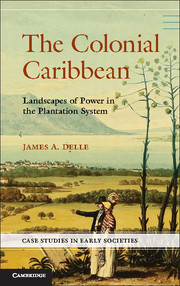Book contents
- Frontmatter
- Contents
- Figures
- Tables
- Preface
- 1 Landscapes of Power in the Colonial Caribbean
- 2 His Majesty’s Island
- 3 The Plantation Mode of Production
- 4 A Class for Itself: Regional Landscapes of the Planter Class
- 5 Contradictions and Dialectics: Village Landscapes of the Enslaved
- 6 Dialectics and Social Change: Plantation Landscapes after Slavery
- 7 Plantation Landscapes in Comparative Perspective
- 8 Conclusion
- References
- Index
Preface
Published online by Cambridge University Press: 05 June 2014
- Frontmatter
- Contents
- Figures
- Tables
- Preface
- 1 Landscapes of Power in the Colonial Caribbean
- 2 His Majesty’s Island
- 3 The Plantation Mode of Production
- 4 A Class for Itself: Regional Landscapes of the Planter Class
- 5 Contradictions and Dialectics: Village Landscapes of the Enslaved
- 6 Dialectics and Social Change: Plantation Landscapes after Slavery
- 7 Plantation Landscapes in Comparative Perspective
- 8 Conclusion
- References
- Index
Summary
In following the format for Case Studies in Early Societies, this volume explores a former civilization, the plantation society of colonial-period Jamaica, framing the analysis of fieldwork within a coherent theoretical structure. The theory that structures this book, Marxism, has a long history of use by Anglo-American archaeologists, dating from at least the work of V. Gordon Childe through to the twenty-first century. Some readers may enter this book from a frame of reference dismissive of Marxism, its basis in materialism, and its focus on the development of class structure and dialectical conflict; others may be curious about how Marxist theory can be used to create understandings of the archaeological past. It is on this latter audience that I have focused my writing. It was my intention when starting out on this book to simultaneously present a thoughtful analysis of the archaeology of plantation Jamaica and to provide an introduction to Marxist archaeology. Knowing that many readers will have had only a cursory introduction to Marxist theory, I have endeavored to explain some of the primary concepts that inform Marxist archaeology without overly depending on jargon. I hope those with a deeper understanding of Marxism will forgive my occasional definition of terms with which they may already be familiar.
There are many people to whom I owe a debt of gratitude for the completion of this book. First and foremost of these is Rita P. Wright, the series editor for Cambridge University Press’s Case Studies in Early Societies series. I was flattered that Rita asked me to contribute this volume to the series, and I thank her for her patience while I wrote it. I am also grateful to the editorial staff at Cambridge, including Beatrice Rehl, Anastasia Graf, and Isabella Vitti. Two colleagues whom I hold in the highest regard, Tom Patterson and Chuck Orser, read and commented on a complete draft of this manuscript, and, as always, I learned a great deal from their thoughtful comments, which helped guide and refine my thinking through the process of revision.
- Type
- Chapter
- Information
- The Colonial CaribbeanLandscapes of Power in Jamaica's Plantation System, pp. xiii - xviPublisher: Cambridge University PressPrint publication year: 2014

